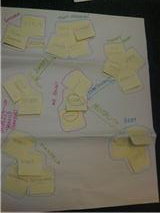Project B has been fun and challenging. Fun because we got to develop, explore and decide on our own, and challenging because of group work and my own limitations. We quickly decided on a group, which consisted of Maria, Vanessa, Vivian, Andrea and me. We initially had many ideas of businesses we wanted to go into, everything from eco-friendly travelling to consultancy. We ended up with a consultancy, named Blue Orchid. It was beneficial for us that we all wanted to go in the same direction, when deciding upon a business. We all wanted to do something more that just making profits. We wanted to aid and enhance the role of craftsmen around the world.
Back in the days the craftsman was a valued community role, due to the knowledge that he/she possessed. It was vital for the community’s wellbeing that the knowledge of material and craft was passed down through generations. The craftsmen operated as a link from land via materials, through process via craft and to user via business. Then the industrial revolution brought about a shift in the craftsman’s role. The focus was on profits and mass production, and the value of the craftsman was suddenly not as important anymore. The focus was now on the design process, instead on the actual craftsman and his/her knowledge.
We wanted to bring back the focus on the craftsman, and shift the centre of attention from a mass-producing profit seeking focus, to a value and knowledge focus. We did not want authentic and distinct knowledge and products to be stepped on by the big chains anymore. This would have to be done through consulting local craftsmen around the world. Aiding them in gaining brand awareness and increasing brand value through our expertise. Blue Orchid would act as a knowledge exchanger, where we provide up to date expertise in marketing, sales, design, distribution and management, in exchange for their crafts knowledge. It is a win-win equation, where both parties benefit from each other. Together we will be a stronger team, and it is our job to prove this to our clients. Blue Orchid is a London based company providing global expertise in creating holistic brand solutions for craftsmen in emerging markets. We want to help craftsmen realise how to fully maximize their opportunities of benefiting from increased tourism. Our service is made with local jewellers in mind, strengthening their commercial value through having us as partners. Our main focus will be on brand revival creating sustainable local enterprises, while satisfying the need of the cosmopolitan consumer.
We were lucky enough to have Vivian in our group, who explained about the local jewellers in the Seychelles, and the potential of developing a collaboration with them as a starting point. These local craftsmen are mainly concerned with producing their own jewellery, but they are not aware of current trends that could increase their sales. We saw this market as an excellent starting point and a feasible business opportunity.
I enjoyed this project, but as previously mentioned – it was challenging. We started of excellent, and we were all motivated and excited about our business plan. I personally fell of the wagon after the Easter break, and when thinking about it now it was probably because I am used to do smaller projects quickly and then hand them in. This project was more complex – both in duration and the actual process. When I would usually hand in a project, this project was not close to done. I got a bit restless and unmotivated, as I felt I had nothing more to give and would rather see this project finished sooner than later. I quickly realised that I had to put my business ways of doing things aside, and focus on the design process. When I managed to do that, I realised that we all had so much more to give, and that a project only gets better the more time you allow for it to grow. I realise now that we could have had even another more weeks, to develop our ideas even further. This is a new way of thinking for me, as I usually begin something only to end it. I work hard to see the final outcome, but through this project I realised that the process should be the main focus. The process is what creates a well-developed outcome.

























